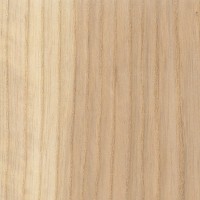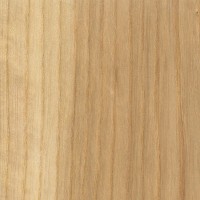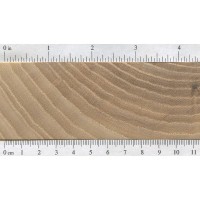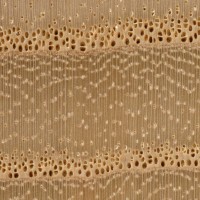 |
Common Name(s): White Ash, American White Ash Scientific Name: Fraxinus americana Distribution: Eastern North America Tree Size: 65-100 ft (20-30 m) tall, 2-5 ft (.6-1.5 m) trunk diameter Average Dried Weight: 42 lbs/ft3 (675 kg/m3) Specific Gravity (Basic, 12% MC): .55, .67 Janka Hardness: 1,320 lbf (5,870 N) Modulus of Rupture: 15,000 lbf/in2 (103.5 MPa) Elastic Modulus: 1,740,000 lbf/in2 (12.00 GPa) Crushing Strength: 7,410 lbf/in2 (51.1 MPa) Shrinkage: Radial: 4.9%, Tangential: 7.8%, Volumetric: 13.3%, T/R Ratio: 1.6 |
Color/Appearance: The heartwood is a light to medium brown color. Sapwood can be very wide, and tends to be a beige or light brown; not always clearly or sharply demarcated from heartwood.
Grain/Texture: Has a medium to coarse texture similar to oak. The grain is almost always straight and regular, though sometimes moderately curly or figured boards can be found.
Endgrain: Ring-porous; large earlywood pores 2-4 rows wide, small latewood pores solitary and radial multiples; tyloses common; parenchyma banded (marginal), paratracheal parenchyma around latewood pores vasicentric, winged and confluent; narrow rays, spacing normal.
Rot Resistance: Heartwood is rated as perishable, or only slightly durable in regard to decay. Ash is also not resistant to insect attack.
Workability: Produces good results with hand or machine tools. Responds well to steam bending. Glues, stains, and finishes well.
Odor: Can have a distinct, moderately unpleasant smell when being worked.
Allergies/Toxicity: Ash in the Fraxinus genus has been reported to cause skin irritation, and a decrease in lung function. See the articles Wood Allergies and Toxicity and Wood Dust Safety for more information.
Pricing/Availability: Ash is among the least expensive utility hardwoods available domestically; it should compare similarly to oak in terms of price.
Sustainability: This wood species is not listed in the CITES Appendices, but is on the IUCN Red List. It is listed as critically endangered due to a projected population reduction of over 80% in the next three generations, caused by effects of introduced taxa. (See notes on the emerald ash borer in the comments section below.)
Common Uses: Flooring, millwork, boxes/crates, baseball bats, and other turned objects such as tool handles.
Comments: The emerald ash borer (Agrilus planipennis), believed to have been inadvertently introduced from Asia sometime in the 1990s, was first detected in Michigan in 2002. Lacking natural predators, uncontrolled populations of this invasive species spread very rapidly throughout North America, devastating local populations of ash trees. The beetles’ larvae bore into a tree and feed on the inner bark, eventually killing the entire tree. The insects are responsible for the deaths of hundreds of millions of ash trees across the United States and Canada. Green Ash and Black Ash trees are preferentially attacked by the insects, followed by White Ash and Blue Ash.
White Ash has excellent shock resistance, and along with hickory (Carya spp.), it is one of the most commonly used hardwoods for tool handles in North America—particularly in shovels and hammers where toughness and impact resistance is important.
When stained, ash can look very similar to oak (Quercus spp.), although oaks have much wider rays, which are visible on all wood surfaces—even on flatsawn surfaces, where they appear as short, thin brown lines between the growth rings. Ashes lack these conspicuous rays.









I’ve made some bowls from white ash and noticed some interesting color patterns overlying the wood grain, a darker brown squiggly lines. Wondering if it is from the ash borer or possibly spalting after the tree died?
I believe that patterning is what they call “olive ash.”
Hello! Can you help me to identify the scientific name of this wood? I don’t know if is this white ash (fraxinus americana), green ash (fraxinus pennsylvanica) or other.
While I am not the best at identifying wood, I will say that your wood looks like white ash to me. The few times I’ve seen green ash in person, I have noticed the grains tend to run closer to one another than white ash.
It could very well be white ash.
I think there is a mistake in the Comments section.
“…although oaks have much wider rays, which are visible on all wood surfaces—even on flatsawn surfaces, where they appear as short, thin brown lines between the growth rings.”
On the flatsawn surfaces, you see the wild medullary rays, right? You see those “short thin brown lines between the growth rings” on the quarter-sawn surfaces. No?
Try to think of rays almost like pancakes both standing vertically and oriented like spokes on a wheel within a log. In oak these “pancakes” can be pretty thick. On the endgrain you are looking at the top of the pancake, on flatsawn surfaces you are looking along the edge of the pancake, and on quartersawn surfaces, you see the face of the pancake, what we would call ray fleck. Now I am hungry…
I am wondering what color white ash changes to with age? I have a weaving shuttle made around 1980 with what I THINK is white ash on the sides and red oak on the ends (see pictures). At this stage of the game the color of the two woods is almost the same, but I am sure that when it was made the woods contrasted, since that is characteristic of other tools made by this individual. Does this look like ash and oak? And, if so, would white ash darken like this over a long period of time?
Ash is a reasonable guess. I actually see three different woods here. I see two of the outmost plies which may well be ash. Then the next layer in on each side, I agree the other wood is oak. Then finally in the very center at the tip, it looks like another ring porous hardwood that’s slightly darker. Possibly something like black or honey locust. But with these woods, there are a handful of other ring porous woods that can have a similar appearance to ash, so you’d really have to get a good look at the endgrain to be… Read more »
Thank you, Eric! I was partially basing my assessment on the age of the piece (40+ years) and thinking about what types of wood might have been readily available to woodworkers in the US at the time it was made. In terms of the darker strip, would locust have been something relatively easy to find at that time? I was thinking it might be walnut, because of my understanding that walnut can lighten, rather than darken, with age. Here are a couple more close-ups — one of either end.
Getting a closer look at the central piece, the little rays reminds me of elm.
I made this bench from ash. It’s a heavy beast
Its a beauty!
I have ash hardwood floors in my living room and I love them. These were placed around 12 years ago. I wanted to have them sanded and restained and then have the same thing placed in my bedrooms. But since Ash is an endangered species I don’t think I want to do that. What other species of wood can be placed that would be the closest to looking like Ash?
Just do the ash floors. Nearly all the trees are dead or being killed already. The ash bore beetle is wiping them out. The wood is still usable after killed by the larvae so it can be made into flooring after being killed. You’ll give it a better purpose than what it’s destined for already: mainly firewood or just left to rot. In Indiana where I live we can’t cut and burn them fast enough because there is such an abundance of dead trees. Of the 100 or so that I’ve come across only one was alive and even that was… Read more »
I’ve never seen LIVE ash at a sawmill.
As I understand it there is nothing that will stop the Emerald ash borer from killing just about every ash tree. I think it will become very rare wood. As such, I am trying to find Is any use for including outdoor uses. I know it’s not very rot resistant, I’m experimenting with different ways of making it Rot resistant. My most recent endeavor is with Woodlife Copper Coat. As ash is very porous, this seems like the perfect stuff to suck in and treat the wood whether it’s dipped or brushed on. As anyone had experience in protecting ash… Read more »
Don’t give up on the Ash tree just yet. Here in Maine the EAB hasn’t been detected and I’ve got some beautiful specimens in my forest!
If it’s for tool handles BLO is my go to. For anything that just sits Tim-bor is a really good product, or pentaborate octohydrate if you want the active ingredient.It doesn’t discolor the wood like a lot of other antifungal/insecticide products but it’ll need a top coat like a spar urethane or consistent reapplication after water exposure.
what is the luster of white ash?
low
I am certain that white ash is not 42lbs cubic foot dried weight. It is 37. I surmise that your figures are taken from a forestry handbook. But this is an error. Every child who has swung a baseball bat can tell you it is lighter by far than rock maple (either 43 or 44 lbs/cubic foot). This is true also for all of us who ever used a hoe – ash is the standard wood for small garden tools (and tennis rackets in that long ago time).
14″ x 8″ snare drum I made from ash.
This is a white ash guitar I built from a board someone gave me. Most ash is rather plain, but it sometimes has wonderful figure. The guitar is a prototype for two that I am building for my brothers out of more expensive woods. The top is Sitka spruce. It is light as a feather and sounds fantastic, and I’m a little afraid that my brothers’ bubinga and Tasmanian blackwood guitars won’t sound as good.
Incredible work! and what a beautiful piece of wood. I bet it sounds great.
Hi There, I have cladded the exterior of a house with this timber, treated it with a lime wash, however it is rotting and bowing, would you recommend this timber for exterior cladding and what would you seal it with.
Next time look into ThermoWood Ash manufactured by Scottywood in Canada
hi is this a hardwood
Yes, it is.
I am thinking of having an African bass drum known as a doudoumba made of white ash.
I am restoring an old fiberglass fishing rod that is estimated at about 40-50 yrs old give or take 10 years.. Was this a common hardwood used in fishing rod handles? It looks very similar.
I restored a 1941 Packard Woody and we had to use bleach to get the oil and dirt out of the wood. It was white ash and for a finish we used automotive urethane. We applied 3 coats then wet sanded, applied 3 more coats wet sanded again and then applied 3 finish coats. After finishing you will want to seal between the panels and the frame.
i am restoring 1949 chrysler town&country convertible,it has white ash on it.I sanded down old varnish, then i have been applying acid. I cant seem to get the grain bleached,the grain seems to either have dirt or old varnish imbedded. Do I keep applying the oxalic acid ? After I get All the wood bleached uniformly,I would like to use a red oak stain to bring out the grain color. Do I need to use a grain filler before or after staining ? Final finish I will be using a marine spar varnish I would appreciate your input on restoreing… Read more »
Hi everyone, Moss here, can someone help identify if my trunk is Ash or not?
Can’t see any moss on that trunk